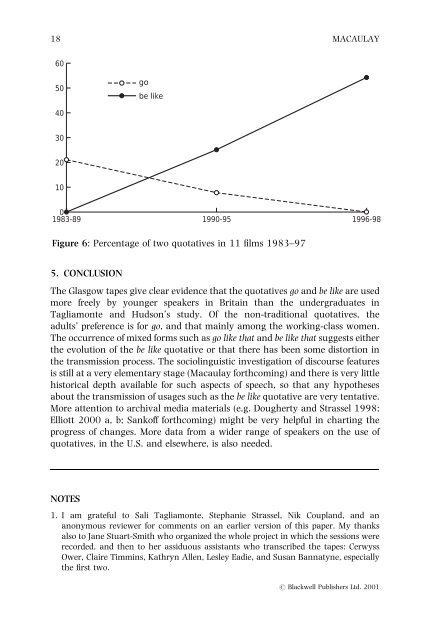You're like `why not?' The quotative expressions of Glasgow ...
You're like `why not?' The quotative expressions of Glasgow ...
You're like `why not?' The quotative expressions of Glasgow ...
You also want an ePaper? Increase the reach of your titles
YUMPU automatically turns print PDFs into web optimized ePapers that Google loves.
18<br />
60<br />
50<br />
40<br />
30<br />
20<br />
10<br />
0<br />
1983-89 1990-95<br />
5. CONCLUSION<br />
<strong>The</strong> <strong>Glasgow</strong> tapes give clear evidence that the <strong>quotative</strong>s go and be <strong>like</strong> are used<br />
more freely by younger speakers in Britain than the undergraduates in<br />
Tagliamonte and Hudson's study. Of the non-traditional <strong>quotative</strong>s, the<br />
adults' preference is for go, and that mainly among the working-class women.<br />
<strong>The</strong> occurrence <strong>of</strong> mixed forms such as go <strong>like</strong> that and be <strong>like</strong> that suggests either<br />
the evolution <strong>of</strong> the be <strong>like</strong> <strong>quotative</strong> or that there has been some distortion in<br />
the transmission process. <strong>The</strong> sociolinguistic investigation <strong>of</strong> discourse features<br />
is still at a very elementary stage Macaulay forthcoming) and there is very little<br />
historical depth available for such aspects <strong>of</strong> speech, so that any hypotheses<br />
about the transmission <strong>of</strong> usages such as the be <strong>like</strong> <strong>quotative</strong> are very tentative.<br />
More attention to archival media materials e.g. Dougherty and Strassel 1998;<br />
Elliott 2000 a, b; Sanko€ forthcoming) might be very helpful in charting the<br />
progress <strong>of</strong> changes. More data from a wider range <strong>of</strong> speakers on the use <strong>of</strong><br />
<strong>quotative</strong>s, in the U.S. and elsewhere, is also needed.<br />
NOTES<br />
go<br />
be <strong>like</strong><br />
Figure 6: Percentage <strong>of</strong> two <strong>quotative</strong>s in 11 ®lms 1983±97<br />
MACAULAY<br />
1996-98<br />
1. I am grateful to Sali Tagliamonte, Stephanie Strassel, Nik Coupland, and an<br />
anonymous reviewer for comments on an earlier version <strong>of</strong> this paper. My thanks<br />
also to Jane Stuart-Smith who organized the whole project in which the sessions were<br />
recorded, and then to her assiduous assistants who transcribed the tapes: Cerwyss<br />
Ower, Claire Timmins, Kathryn Allen, Lesley Eadie, and Susan Bannatyne, especially<br />
the ®rst two.<br />
# Blackwell Publishers Ltd. 2001
















